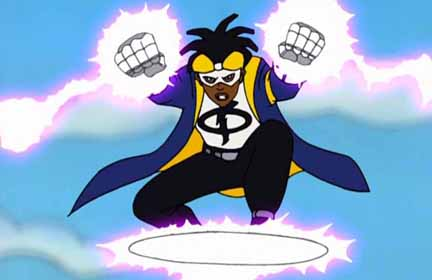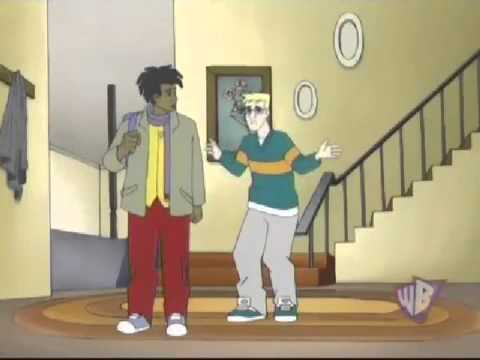This content has been archived. It may no longer be relevant

Nostalgia aside, looking back on the 90’s and early 2000’s, it is easy to argue that it was a golden era for animated series, particularly for comic book fans. Some of the best comic book adapted cartoons ever produced came during this time. The D.C animated universe of the 90’s gave us Batman and Superman animated series, two of best written cartoons of the decade. Then it followed up with Justice League, a show which will always hold a special place in the hearts of fans. Although these shows deserve their praise, there is another series during this sentimental era that is worthy of equal praise, yet often ignored; Static Shock.
When I was kid, Static Shock was the show that I made sure I watched on Saturday mornings. There were even times that I’d slack off my chores to watch it, knowing that I was going to get my mother mad. I didn’t care, it was worth a potential punishment to finally see a black kid like me being a superhero. I’m not going to lie and say that Static Shock was perfect. It wasn’t, nothing ever is. As fans, we have to be honest about the issues in the media that we like. We can enjoy something while providing a critique of it as well. Static Shock is no different. That being said, the show was still allowed black kids to see someone who looked and spoke like them being a hero.

Static Shock was a series released in 2000. The show followed protagonist Virgil Hawkins, a young black high school student in Dakota City, as he tries to control his granted electric powers that was caused by a chemical explosion. He takes his powers and brands himself Static, the city’s guardian.
What made Static Shock such a good series is that the protagonist was flawed, he was not perfect. While the era did have some great animation, it didn’t have much progress what it came to diversity and representation. There were very few black heroes in the D.C animated universe. The one hero that comes to mind is Justice League member John Stewart, the Green Lantern. Stewart is probably one of the most well-known black heroes in comics. On Justice League, he was the strongest willed and most determined character. He always seemed to be confident in his decisions and never really showed a moment of weakness; as empowering as that is, that wasn’t exactly me. This is why I struggled to see myself in his character. John Stewart was always strong and constantly sure of himself and I just wasn’t. Virgil Hawkins, on the other hand, embraced his imperfections. He was a black kid who would make mistakes and learn from them. He had his flaws, vices, and insecurities. I was a black kid who would make mistakes and learn from them. I had my flaws, vices, and insecurities.
Virgil showed me that it was okay to be human. When it comes to representation, it is important to show characters who have flaws and insecurities. No person has the ability to always be strong or always be confident in their choices. Marginalized groups often do not allow themselves to feel this way as they focus on fighting their oppressors. They force themselves to be strong so that they can survive. However, it is important to be reminded that marginalized groups have the right to be a human being. Characters that are suppose represent marginalized groups should let them know this.
Static Shock continues to be snubbed of the recognition it deserves. It had writing and animation on par with some of the best cartoons of the time. Not only that, but it also highlighted a number of social issues, ranging from racism to school shootings. It taught me about problems and aspects of society that no one was talking about.

There is one episode that caught my attention particularly. It is titled “Sons of the Father.” In that episode, Virgil finally meets his friend Richie’s father, who Richie attempted to keep away due to the fact that he is a racist. That fails and Richie’s father treats Virgil as though he is less than human. He doesn’t come right out and say it but you can tell via the social cues. Virgial later overhears him calling all black people “Hoods.” Richie finally has enough and airs his father out. This scene stood out to me with regards to the series. At this point in my life, I had experienced racism and people simply stood by and pretended it didn’t happen. It wasn’t blatant and open racism, it was subtle and passive aggressive, just like the Richie’s father. The scene was the most accurate display of racism I had seen at that point.
Another aspect of the scene which stood out to me is Richie calling out his father’s racism. It is not the job for black people to fix racism in America. Neither did we start it nor are we the major aggressors. White people are the ones who founded it, institutionalized it and profited the most from it. Therefore, it is their job to tear down the constructions of racism that they had built, both systematically and socially. Richie calling out his father is what every person who has racist friends or family members needs to do. It is an example of what so called “allies” need to do if they want to continue to stand up for our issues. By remaining silent, they are complicit in these racist systems and their opportunities of bringing this much-needed positive transformation falls away.
Static Shock will always have a special place in my heart. It was an important part of my childhood. I hope that the next generation of kids can watch a show, on Saturday mornings, slacking off their chores despite knowing their inevitable punishment, which gives them representation and allows them to see themselves in these characters while addressing relevant issues like I had.
By: Jaylen Pearson
Editor: Ammaarah Mookadam
 From Pretty Little Liars to May December: Grooming in Media
From Pretty Little Liars to May December: Grooming in Media  X-Men ‘97: An Adventurous Series Filled with Nostalgia
X-Men ‘97: An Adventurous Series Filled with Nostalgia  The Disappointing Reinvention of Netflix’s Avatar: The Last Airbender
The Disappointing Reinvention of Netflix’s Avatar: The Last Airbender  Iwájú: A Triumphant Tale of Two Friends and Two Worlds
Iwájú: A Triumphant Tale of Two Friends and Two Worlds  One Day is a Wonderfully Heartbreaking Love Story
One Day is a Wonderfully Heartbreaking Love Story 